Tactical Movement (Part 1) from our New Infantry Combat Online Course
This short article is taken from our new Squad-Level Infantry Rural Combat book which includes 200-pages of detailed full-color pictures and diagrams. The article discusses how to incorporate individual movement techniques into small-unit tactical movement in a real-world combat scenario. Even if a unit masters movement formations and techniques they may still find themselves at a great disadvantage in combat against an adversary that better knows how to apply those techniques to the reality of combat.
Phases of Protection Operations
The security mission never stops. If a detail is protecting a VIP against a serious threat, they will need to provide security 24-hours per-day and 7-days per week. It is impossible to predict where and when an attack might take place. Even if the VIP cannot afford round-the-clock security, there must still be plans and measures in place to maintain security at all times. Therefore as time passes, security operations generally fall into three phases or categories: site security (including compound, building, office, home etc.), mobile security and venue security.
Vehicle Selection for Executive Protection Operations
There are many factors to be considered when selecting vehicles for a motorcade. In some cases, you will not have a choice and will have to work with whatever vehicles are available. Regardless, as the security detail it is your responsibility to know your vehicles and understand their advantages and disadvantages. This short article is taken from our new Escort Detail Mobile VIP Protection Online Course. It discusses considerations for choosing the right vehicle for a motorcade or protective detail.
Mobile Security Fundamentals
Mobile security focuses on protecting the VIP when he/she is moving from one point to another. The VIP could be moving from his/her home to a venue or moving between scheduled and unscheduled stops. While the techniques of VIP protection vary widely depending on the situation and a number of influencing factors, there are certain core concepts and fundamentals that apply to almost all aspects of mobile security operations.
VIP Protection: Motorcade Counter-Ambush
Should the limo/motorcade come under attack, the detail generally has four options to be executed in the following order of priority: drive through, push out, crossload or evac/bailout. This article provides a general discussion of each of these four options along with some of their advantages and disadvantages. The full book goes into great detail on how to execute each procedure from different directions of attack and with different size details.
Two-Person CQB: Fighting Outside of Buildings (Part 2)
If you have to move through an urban environment where threats could emerge from any building or direction, you must be prepared to move tactically in the safest way possible. Urban movement tactics are particularly useful for dealing with terrorist attacks or active shooter (deadly attacker) scenarios. The last installment in this two-part article focused on cover and concealment. This second part focuses on crossing alleys and streets.
Two-Person CQB: Fighting Outside of Buildings (Part 1)
If you have to move through an urban environment where threats could emerge from any building or direction, you must be prepared to move tactically in the safest way possible. Urban movement tactics are particularly useful for dealing with terrorist attacks or active shooter (deadly attacker) scenarios. This short article is taken from our Two-Person CQB Online Course and companion book. It provides a brief discussion of how to move and fight in the street or in-between buildings in an urban environment.
Two-Person CQB: Training for the Fight
Training is particularly important for two-person operations. Not only do you need to know how to perform various techniques yourself, but you and your partner need to know how to work as a team and coordinate your actions in a safe manner. Whenever you are operating as a team with more than one person, there is a significant risk of friendly fire. Effective training, practice and rehearsals offer the best way to avoid friendly fire accidents.
Singleton CQB: Shallow Entry Technique (Part 2 of 2)
The shallow entry techniques (sometimes called “limited penetration” techniques) are designed to prevent you from becoming over-committed or trapped deep in a target room. In single-person operations, it is often better to stay closer to a door so you can quickly move through it to avoid threats coming from either direction. This short article is taken from our Single-Person CQB Online Course and companion book. It provides step-by-step instructions for conducting the shallow entry technique. We will explain this technique in two articles. This article explains the second half of the technique.
Singleton CQB: Shallow Entry Technique (Part 1 of 2)
The shallow entry techniques (sometimes called “limited penetration” techniques) are designed to prevent you from becoming over-committed or trapped deep in a target room. In single-person operations, it is often better to stay closer to a door so you can quickly move through it to avoid threats coming from either direction. This short article is taken from our Single-Person CQB Online Course and companion book. It provides step-by-step instructions for conducting the shallow entry technique. We will explain this technique in two articles. This article explains the first half of the technique.
Singleton CQB: Active Shooter and Sniper Response
Unfortunately, deadly attacker (active shooter) situations are becoming more and more common. Most deadly attackers are perpetrating acts of terrorism, are very committed, ready to die and seek to cause maximum death and destruction. This short article is taken from our Single-Person CQB Online Course and companion book. It provides a brief discussion of how to employ the principles of Single-Person CQB tactics when faced with an active shooter (deadly attacker) or sniper attack.
How is Singleton CQB Different from Team Operations?
Single-person (Singleton) CQB tactics are different from tactics developed for teams and multiple teams. The reason for this is the increased risk associated with operating alone. Even if you are very experienced in team-level operations, it may still take time for you to master the specific skills and movements needed for single-person operations. This short article is taken from the introduction to our Single-Person CQB Online Course and companion book. It provides a brief discussion of how CQB tactics change when you are operating alone.
Singleton CQB to Counter a Home Invasion
Since launching our new in-person training initiative we have received some requests to cover single-person (singleton) and two-person close quarters battle (CQB) techniques in a home invasion scenario. The article below is a partial extract from our Single-Person CQB course which is now live on the Tactics Society online academy. We recommend our single-person and two-person CQB courses for any gun owners who want to better protect their homes.
DISCUSSION: A Better Way to Train - Part 1
Many of the world’s premier training and education institutions, including prestigious universities like Harvard and Yale are predominantly still operating the same way they were one-hundred years ago. Are there new, better ways to train that people are ignoring? We want to start by opening up the discussion to our readers. Visit our Facebook page and post your comments under this article.
Join Us for Live, In-Person Training
For the first time, Special Tactics is honored to offer live, in-person training courses for civilians, law-enforcement officers and military personnel provided by senior special operations veterans from Tier-1 Special Missions Units. We will be publishing more articles on our training philosophy and innovative training methods in the days and weeks to come.
Get Certified at our New Online Academy
After many months of work and transition our new online academy is now live through our partnered organization, The Tactics Society. The new online academy is easier to use, more streamlined and offers serial-numbered, printable PDF certificates for the completion of each course.
Small War Tactics: Lines of Operations
Our new book, the Small War Tactics: Professional Handbook is now out on Amazon Kindle. We hope it becomes a valuable addition to your tactical library. The following article is drawn from the book’s introduction, summarizing the various “lines of operation” covered in the book and discussing how to integrate those efforts towards a strategic endstate. There is no fixed way to structure efforts and operations so they integrate together effectively. The key is for leaders to think creatively and collaboratively about the specific problem and the resources/capabilities available to come up with a unique and effective solution.
Small War Tactics: Traffic Control Points (TCP)
The Small War Tactics: Professional Handbook is coming out soon on Amazon Kindle. Here is another short article from the book, this one focusing on how to set up Traffic Control Points (TCP) to support counterinsurgency operations. The nature of insurgent operations also frequently requires them to move. For example, they might need to smuggle explosives in from another region, build a bomb in one location, stage it in another location and then deploy it at a another location. All of this requires movement. By making it more difficult for insurgents to move about, you increase the level of security in the area. Emplacing TCPs is one way to limit insurgent mobility.
Small War Tactics: Downed Vehicle Drills
Special Tactics is excited to announce the upcoming release of our new book Small War Tactics: Professional Handbook. The book covers lessons learned from the past 20 years of fighting counterinsurgency battles and low-intensity conflicts around the world. Some specific topics include direct action targeting (F3EAD - unclassified), counter-IED operations, psychological operations, force protection and base defense operations, traffic control point setup and employment, tactical questioning and sensitive site exploitation (SSE). The book will be available on Amazon Kindle in the coming weeks.
Advanced CQB Equipment 1: Assault Kit Introduction
There are no “right answers” when it comes to equipment setup. The most important thing is finding a setup that is effective for you and what works for one person might not work for another. However, it can be helpful to share general ideas and principles or specific tips/techniques when it comes to equipment setup since equipment configuration is a never-ending process and there is always a way to make your kit layout function a bit better. This first article in the Advanced CQB Equipment series covers some of the most basic concepts and ideas relating to kit layout.




















